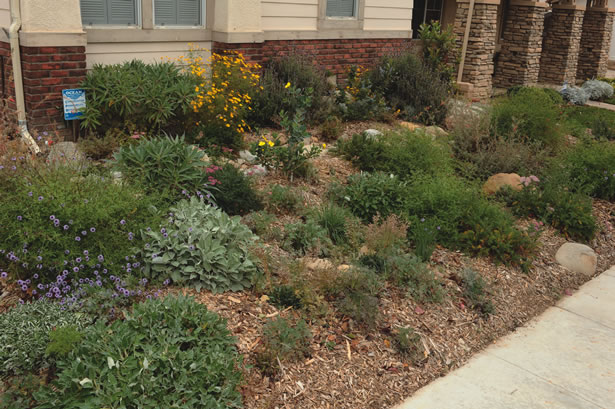Reduce runoff and ocean pollution by rethinking your outdoor spaces. – By Chad Nelsen
The first time I ever heard about a barn raising was on “Little House on the Prairie.” I remember thinking it was an amazing concept; neighbors getting together to help one another raise the sides and get the roof joists up on a large barn. It’s not something you are likely to see in Laguna Beach, at least not for barns. That said, the Surfrider Foundation’s new Ocean Friendly Gardens program takes a similar approach by getting neighbors to work together to convert their yards to ocean-friendly landscapes.
Outside of Laguna’s core urban area downtown and along Coast Highway, the large majority of the developed part of the city is residential homes and apartments. Each of these dwellings has landscaping that likely contributes to our urban runoff problems in some small way. When added up, they are a key contributor to the water quality challenges we face. Other contributors are urbanized areas, parking lots and roads. The big difference being that each of us has at least some control over what happens on the little piece of earth that we live on.
While most eco-friendly garden programs are focused on water conservation, the Surfrider Foundation’s Ocean Friendly Gardens program takes that a step further. The program is focused on three components: Conservation, Permeability and Retention (CPR).
Conservation
Conservation means saving water by planting climate-adapted or native plants. Not only do these plants save water, which also results in less runoff spilling out of your yard, they also reduce certain pest populations, meaning you can significantly reduce your application of herbicides and pesticides. A drier landscape also allows the soil to retain more moisture when it rains, further reducing runoff.
You can take your conservation efforts even further by installing a rain barrel to collect rain water running off your roof and store it for later use. Smart timers that turn your sprinklers on only when they’re needed can also help conserve water.
As Christopher Regan, assistant general manager at the Laguna Beach County Water District explains, not only will these efforts help conserve water, they can also save you money. “Over 60 percent of water used by households in Laguna Beach is used for landscaping,” he says. “And we are constantly concerned about runoff because any water running off your property is wasted water and wasted money.”
The Laguna Beach County Water District offers a number of programs to help save water and money, including an annual rain barrel contest and demonstration rain barrels installed at their downtown offices, right across the street from the fire department on Third Street. Christopher also notes that a number of the climate-adapted plants in their demo garden are also fire-resistant. The water district offers rebates for installing smart controllers or getting rid of turf.
Grass be Gone
There is no question that lawns are great places to play, but lawns are notoriously bad for the ocean. Not only do they require a lot of water, but the runoff they produce is loaded with fertilizers and herbicides. Amazingly enough, a mature lawn can be 80 percent impervious to water, meaning that when it rains a lawn is not that different than pavement when it comes to runoff. Instead of a lawn, there are many attractive alternatives that naturally belong in your climate region.
Permeability
The second step in creating an ocean-friendly garden is increasing permeability in your yard so that irrigation and rainwater can soak into the ground. The primary way to increase permeability is to reduce the amount of impervious surfaces, which are surfaces like pavement or concrete that don’t absorb water. Increasing the amount of permeable surfaces in your yard stops water from flowing off your property and instead allows water to soak into the soil in your yard.
Some techniques used to increase permeability are redesigning driveways, rethinking the paths that lead around your house and getting creative with patios. Some alternatives to concrete in heavily used areas include brick, decking, pavers, porous asphalt and stone. For medium-use areas, consider crushed aggregate, decomposed granite or turf block. Low-use areas can employ hearty groundcover and mulch.
Retention
The final step is designing your landscaping to retain water on site. Retention gives the water an opportunity to infiltrate the ground beneath your yard, and this infiltration can directly contribute to a community’s water supply by recharging groundwater, while simultaneously reducing polluted runoff. Water can be retained on your property by creating topographic features that channel and collect water known as retention basins and swales. There are also more advanced techniques that can be employed, such as small dry wells that store water in underground while it soaks in.
For landscapes that can’t afford to load up the land with water due to shallow clay soils or concerns about geologic stability, the goal becomes “screening” the exiting water. Screening slows the water to allow partial percolation and makes use of soil or vegetation to absorb or filter out pollutants.
What You Can Do
Even without the workshops and classes, each and every one of us can help make our landscapes more ocean-friendly by thinking about adding conservation, permeability and retention to our gardens. The Laguna Beach County Water District’s demonstration garden is a good place to stop and see just how attractive and ocean-friendly a garden can be. LBM






